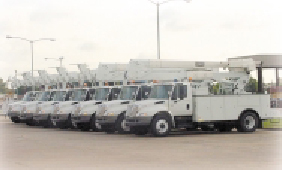
With the challenging demands in the marketplace, increased understanding of ownership and operating cost as well as utilization are important to help make critical decisions with capital equipment. Buy – sell, rent – lease, or repair are important decisions often made without adequate information. Today’s fleet managers have tools available to assist understanding fleet issues regardless of fleet size and location.
Significant improvements in ownership and operating costs, as well as utilization, have been made by working directly with customers. Still, greater progress can be realized utilizing new available fleet management tools.
Various fleet management services and software packages have been developed and are available throughout the heavy construction industry. The goal of these services and software packages are to provide information to assist with making fleet decisions. FleetEdge is an example of fleet management services that has been customized for the utility industry.
Claude Masters is the Fleet Administrator for Reliant Energy – Houston Metro of Houston, Texas. Reliant Energy – Houston Metro made the decision to use fleet management services. Claude explained the reasons for choosing a fleet management service by "the decision to use the product “FleetEdge” was predicated on the ability of this system to utilize current and future technologies enabling our fleet to take a proactive or predictive approach to fleet management. The system aligns with our strategy to maximize the value of technology provided by the Original Equipment Manufacturer while providing the flexibility to modify the system to fit application specific requirements".
In order to understand the benefits of the system, it is important to understand the data collection process. Keith Goode, Operations Manager for Commercial Body Corporation based in San Antonio, Texas, explained today’s processes require minimal input with most information being compiled automatically after initial implementation. The collection system is a straightforward process and provides up to date information quickly and relatively inexpensively. Commercial Body Corporation is the final stage manufacturer for Terex Telelect products as well as FleetEdge provider.
The information provided by the service or system must be clear, understandable, and formatted to assist with fleet decisions. Often too much information is of little help if not presented correctly.
How it Works
Information Gathering Process summarized from FleetEge.com
Equipment Up-Fitted
A black box (mini-computer processor) is fitted on the equipment. A variety of sensors and alarms are selected based on the requested monitoring parameters. GPS equipment may also be fitted to monitor location. Typically monitoring parameters include low engine oil pressure, high engine operating temperature, high transmission operating temperature, high hydraulic oil temperature, engine hours, and PTO hours. The system can also be setup to log specific events or even trigger an alarm if a set condition is met.
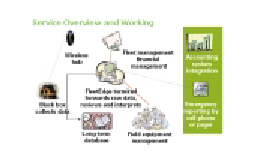
Examples of parameters that might additionally be monitored are hydaulic pressure, boom out of stow, or operation outside a specific geographic area.
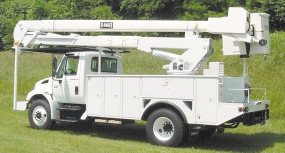
Black Box Collects the Data
Cellular or satellite networks provide wireless data transfer solution. Depending on the application, size, market geography and existing wireless infrastructure a specific system may be more cost effective and selected. This is very important to today’s industry since it actually reduces manpower required to accumulate data.
Wireless Hub
The raw data is collected at a hub and checked for errors and format. The data then flows via the Internet to the computer servers where it is uploaded in the database. Allowing the data to be collected automatically minimizes the chances of human input error.
Accounting System Integration
Advanced fleet management service work with clients to collect equipment accounting data. A secure interface is created that transmits information from the accounting system to fleet management service. This process provides the cost data to calculate ownership and operating cost for each specific unit being monitored.
Data Base
Data is configured to fit the client's specific business rules and processes. The data can be maintained by the provider on a secure website with guaranteed accessibility to deliver equipment intelligence on-demand. The database is exclusively the client’s. All that is needed is an Internet connection, which eliminates the cost and effort of keeping up with software upgrades.
Equipment Intelligence
The result of knowing what data to process, how to process and interpret it, and what it means to the specific client for their specific market and application results in usable equipment intelligence.
The most significant benefit is up to date and understandable information. Claude Masters highlighted this benefit by “the ability to capture real time data such as engine hour, odometer and PTO hours that are remotely captured, eliminating the need for manual entry. Additionally, the ability to tie into the (engine computer) J1939 data link will allow for the remote monitoring of engine fault codes, engine operating temperature trends, engine over-speed and idling time. On units with hydraulic equipment you can monitor oil temperature, boom out of cradle events and the number of times the unit has exceeded a hydraulic pressure, etc”.
Additional benefits such as the “event trigger” feature provide valuable immediate notification of a set condition that provide the opportunity to take corrective action to prevent damage and minimize maintenance cost.
A few examples of other reports that help build equipment intelligence are shown.
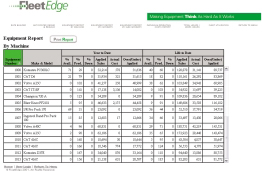 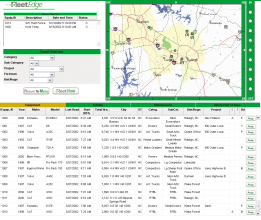 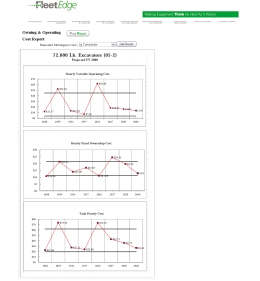 | Equipment Utilization, Downtime & Cost by Machine or Category The report displays any portion of the fleet and can be sorted by the most costly pieces, the least utilized, or the best performing at the touch of a button. The entire fleet is continuously analyzed and presented in an easy, adjustable and printable format. Poor performing equipment can be identified immediately. Fleet Status Equipment Display Listing showing all machines, their categories, their physical locations if GPS devices are installed) and their assignments. The assignments to projects, districts/regions and foremen can be updated right on the screen. Hourly Cost Analysis Benchmarks for the fleet can be set that allow comparing a specific unit to the fleet averages in order to make cost comparisons. Tools a Utility Can Use Other reports that assist with fleet decisions include Category Analysis for Disposal (Owning and Operating Costs), Anticipated Repair & Rebuild, and Fleet Status Alerts Display. “Again, the ability to capture consistent accurate data is the foundation of any FMIS. Data cleansing is an issue with most fleets; systems such as FleetEdge remove the human element ensuring timely accurate data inputs. The ability to expand and modify the system as needs change provides the flexibility to add functionality like GIS at a later date if needed. Other functionality such as utilization vs. operating time will assist with maintenance decisions and could even help automate DOT regulation reporting compliance” said Claude. Claude’s comments summarize the reasons for using new available tools to assist with fleet decisions. Future Evolution Fleet management services and software have come a long way A platform for future expansion and customization is important for continued progression. Claude states it best by "at this point only our imaginations and the resolve to work through the evolutionary technology issues that may arise limit the application possibilities" Quotes & Information Gathered From:
|







